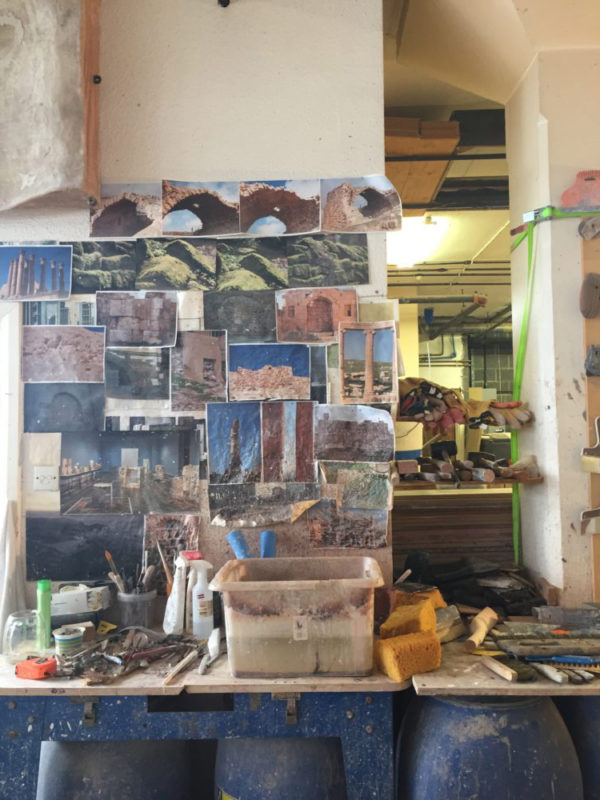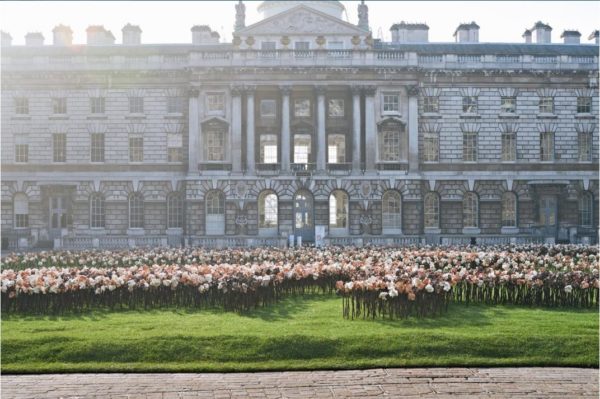The Man
The man with blue eyes is tall like a mountain. His shoulders and back are solid with muscles; the hands are large like stiff gloves and covered with little scars, yet soft and expressive. Many of his pieces are here in his studio ready to be shipped for an exhibition at the Chilean National Museum of Fine Arts in Santiago. ‘I don’t want people to come to the studio without any work in it,’ he said. ‘It does not make sense to see an empty studio.’ Fernando walks around the studio, a little small for the scale of his works, which he touches with affection while talking. He seemed to be excited by the work being brought together again, work that he has not seen for a while.
The Studio
The studio was like a mine. The entire floor, wall to ceiling, is covered with earth and I can see dust floating in the light by the window. The buckets on the floor are covered with plastic to avoid their contents drying out. There are so many that it was hard to find the way to move forward.
Many photographs have been put on the dusty wall; they are already crispy dry and undulated with now-dried moisture. One of them shows a curved ancient arch made with pile of bricks. The artist looks at the image and questions how ancient people could have made such a simple, efficient and beautiful structure. He is totally fascinated by the question, which the ancestors had prepared for him. He does not stop going back and forth between the question and possible answers. With joy.

The Works
His ceramic works are rich in expression. Like the one with blue cobalt inside the brushed white porcelain clay; the one made by putting together the debris from curbing the ceramics; one that captures the trace of his hands negotiating with the clay. All the works free the colour and materiality of their mass of clay, whose softness and hardness meet at the same moment and mingle together. The distortion of the clay has a certain rhythm and makes me think that the motion will continue forever. The material is liberated, full of energy; it even looks comfortable in its shape.
In the corner of the studio, there are works covered by crumbled porcelain, which looks light and airy, like the outside of a coconut shell. As soon as Fernando finds me looking at it, he goes to the pieces and abruptly removes their dusty plastic covering. He pulls the work out from the corner, working the muscles in both his arms and his back. The work seems soft and gentle, but I am totally betrayed by how it looks. It is attached to plinths and has a castor on the bottom, but it still requires all of Fernando’s strength to move. ‘I just ran into the idea of putting the castor in the plinth two or three years ago, and it is great! It changed my life. I used to carry the pieces one by one. The castor saved me.’
The Homeland
Chile was born of earth and lives for earth. Before the European conquest, the country flourished with a culture of digging earth and stone. And now, following in those prosperous footsteps, the country exports minerals all over the world, of which copper is the biggest asset. Yet not many people know how mining has changed the landscape of northern Chile. The land is mined in search of valuable material, such as copper, but once it is taken, what is left behind loses its value and is abandoned. In this way, the deserted land has expanded as mining sites migrate. Since the 1990s, Fernando has been interested in using the earth of this abandoned land – what miners call ‘tailings’ – and has been researching how to integrate it into his work.
On the neatly built shelves in his studio, there are fragments of various colours and ceramics mixtures placed in order. These make up the colour palette of his ceramic sculptures made from desert debris; they are the means by which he brings the abandoned earth into his art.
The Earth
Fernando thinks it is important to use clay from where he is based. When he first moved from Santiago to London in 1997, he brought 12 tonnes of clay with him, but as soon as he started working in his new home, he felt he had to use the clay he found in London. To begin with, he assumed that the clay came from somewhere in the UK, but discovered that much of it came from different parts of Europe. The clay had already travelled a lot before he got his hands on it.

The various ceramic fragments in his studio look like nubs of clay found somewhere in the field, but they are actually important lexicons that he has created for himself. The more he makes, the more he becomes expressive in his work. Fernando constantly keeps trying to mix different clays in order to discover a previously unknown appearance. He believes that all the different clays can be mixed together, become one lump, and then return to the ground whence it came.

The Flowers
In 2012, Fernando covered the courtyard of Somerset House in London with 10,000 ceramic flowers. Commissioned as a temporary art project, he decided not to place the elaborate large-scale public sculpture but to cover the centre of London with ceramics to provide the space for human beings.
Not one of these ceramic flowers was the same shape. He brought copper tailings from Chile, covered white clay with this reddish colour, and made the soft and airy shape of his flowers’ petals by hitting the clay with a bar. The stem was made with iron. All of these materials made the flowers look like abstract painting. Fernando made 200-300 flowers a week; it took him two years to make 10,000. He made each one himself.
In order to install the ceramic flowers, soil was brought into the courtyard of Somerset house and spread out over the courtyard. Then turf was laid and sprinklers put in place to water it. The ceramic and metal flowers were drilled into the soil one by one and, seen from the distance, the flowers became waves of reddish copper colour over the green grass. The ceramic flowers and grass invited fresh air, then insects arrived and birds came, and people came to sit and picnic beneath the blue summer sky. Different lives gathered in the midst of the metropolis.


Three years later, the project, called Out of Sync, came full circle. The 10,000 flowers were taken to northern Chile, to the port city of Antofagasta, and installed in a deserted mining site. The ceramic flowers’ ‘red’ was taken from there. After colouring the ceramic flower, the abandoned copper came home and honoured its land with its red.
The Conflict and Mixture
Fernando uses earth to go beyond country and to interact with the planet’s different surfaces. Through soil, stone, brick and ceramic, he digs out our ancestors’ forgotten cultures and continues practicing techniques that human beings have cultivated over thousands of years. He also transcends geographical boundaries through the materials he uses, as well as the past and present by shaping the clay with his own hands, as if weaving time and space. Thanks to all those processes, his art seems to represent the path of Latin America, a place born of unexpected conflict and a mix of cultures.
The knowledge that he gains from the earth makes him ever more creative, giving his work a quality of being so close to nature that it could just as easily return. This process praises the culture that humans have cultivated while, at the same time, exposing their idiocy, which forces them to destroy nature and its benefits.
Fernando does not insist on a glorious concept behind his art, however. Rather, he looks at the lump of clay in his hand, and says simply, ‘There is everything in this.’
